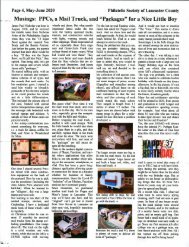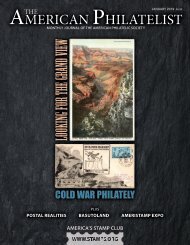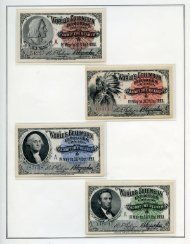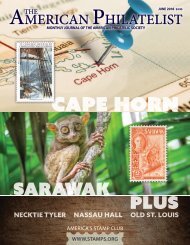August 2018 - Sneak Peek
The American Philatelist is the monthly journal of the American Philatelic Society, the world's largest organization for stamp collectors and enthusiasts. Members receive the printed magazine and can access the digital edition as a benefit of membership in the Society. Please enjoy this sneak peek. We're confident that once you see all that we offer, you'll want to join the APS today.
The American Philatelist is the monthly journal of the American Philatelic Society, the world's largest organization for stamp collectors and enthusiasts. Members receive the printed magazine and can access the digital edition as a benefit of membership in the Society. Please enjoy this sneak peek. We're confident that once you see all that we offer, you'll want to join the APS today.
You also want an ePaper? Increase the reach of your titles
YUMPU automatically turns print PDFs into web optimized ePapers that Google loves.
3¢ DEVILS TOWER NATIONAL MONUMENT<br />
COMMEMORATIVE STAMP<br />
Date of issue: September 24, 1955<br />
Catalogue numbers: Scott 1084<br />
Designer: Charles Ransom Chickering<br />
Vignette engraver: Arthur W. Dintaman<br />
Frame engraver: Robert Joseph Jones<br />
Letter engraver: Robert Joseph Jones<br />
Color: Violet (Scott); purple (Post Office Department)<br />
Format: Electric eye plates of 200 divided into 4 post<br />
office panes of 50 by horizontal gutters - arranged 10<br />
horizontally by 5 vertically<br />
Perforation: 10.5 by 11<br />
Size: 0.84 of an inch by 1.44 inches (21.34mm x 36.58mm)<br />
Printing: Bureau of Engraving and Printing using the<br />
new Experimental Bi-Color Rotary Press (EXBIROW)<br />
popularly called the Huck Press; dry intaglio printing<br />
Anomalies: full gutter within block of four<br />
Quantity issued: 118,180,000<br />
First-day site: Devils Tower, Wyoming<br />
First-day covers serviced: 285,090<br />
PLATE NUMBER REPORT<br />
Plate. No. Impressions Printed<br />
25500 165,011 <strong>August</strong> 29, 1956<br />
25501 165,013 <strong>August</strong> 29, 1956<br />
25502 164,893 <strong>August</strong> 31, 1956<br />
25503 164,894 <strong>August</strong> 31, 1956<br />
ral Bridges (Utah); and in 1909 to Navajo (Arizona), Oregon<br />
Caves (Oregon), and Salinas Pueblo Missions (New Mexico).<br />
Once the Act was in force, Wyoming’s congressman-atlarge,<br />
Franklin Wheeler Mondell (1860-1939), a local prospector<br />
from the northeast part of the state, whose primary<br />
interest at the time was public land issues, introduced a bill<br />
to make the tower the first national monument. Due to his<br />
influence, on the following September 24 Roosevelt declared<br />
the site the first national monument. It encompassed 1,347<br />
acres (545 hectares) as the first of these protected sites. In<br />
1916, it was put under the jurisdiction of the newly created<br />
National Park Service.<br />
Over the years climbing the Devils Tower became an increasingly<br />
popular pastime. The first formal ascent occurred<br />
on July 4, 1893, by two local ranchers, William Rogers and<br />
Willard Ripley. They completed the climb after constructing<br />
a ladder of wooden pegs driven into cracks in the rock face.<br />
A few of these wooden pegs are still intact and are visible on<br />
the tower. Lizzie Rogers, Williams’ wife, was the first woman<br />
to reach the summit in 1895. The most famous for climbing<br />
the tower using modern techniques was Fritz Wiessner, accompanied<br />
by William P. House and Lawrence Coveney on<br />
June 29, 1937. The first all-female team – Jan Conn and Jane<br />
Showacre – climbed the summit in 1952.<br />
On October 1, 1941, George Hopkins parachuted onto<br />
Devils Tower, without permission, as a publicity stunt resulting<br />
from a bet. He had intended to descend the summit by<br />
a rope, which never arrived. He was rescued after a week at<br />
great cost when a Dartmouth student traveled cross-country<br />
to fetch him down. By the 1950s, hundreds of climbers scaled<br />
the sheer rock walls of Devils Tower each summer. The number<br />
of visitors reached 100,919 in 1954.<br />
We come full circle back to Native Americans. During the<br />
1950s, with the rising crescendo of demands for civil rights<br />
and racial equality, Native American communities had not<br />
yet to become as vocal as they were to be in subsequent years.<br />
The first stirrings of such a movement could be detected in<br />
demands that Devils Tower be protected against rock climbers,<br />
who in the eyes of the Lakota, Cheyenne and Kiowa, desecrated<br />
an important religious site. Years of resentment and<br />
rancor against the climbers and what were regarded as their<br />
sacrilegious activities were beginning to be heard. Climbers<br />
countered by arguing that their “connection to the tower is<br />
also a spiritual one.” A settlement, including changing the<br />
name of the monument to something less obnoxious to the<br />
ears of Native American ears, is still pending.<br />
And then there are mashed potatoes! The uniqueness and<br />
the visual strength of Devils Tower likely received its greatest<br />
exposure with the 1977 release of the Stephen Spielberg motion<br />
picture, Close Encounters of the Third Kind. In the film,<br />
characters are drawn to the magnificent structure, which<br />
eventually becomes a landing area for aliens. In one memorable<br />
scene, his family watches in silent awe as actor Richard<br />
Dreyfuss builds a model of Devils Tower out of a huge plate<br />
of mashed potatoes, using his fork to create the tower’s striations.<br />
“This means something; it’s important,” Dreyfuss utters<br />
through tears. (See sidebar.)<br />
First-day Ceremony<br />
Prior to the first-day ceremony, events were held, starting<br />
in June. They took place at towns like Belle Fourche, Hulett,<br />
Deadwood, Sundance, Lead, Gillette, Newcastle and Spearfish.<br />
The main pre-ceremony event was the Pioneers Picnic<br />
held at the foot of Devils Tower with Don Howe presiding.<br />
It featured concerts by local bands and speeches delivered by<br />
McIntyre and Howard Baker.<br />
As part of the build-up to the big day, a special mountaineers’<br />
week occurred between July 14 and 22. Army and<br />
overseas climbing teams were featured.<br />
On the Saturday and Sunday just before the first-day ceremony,<br />
F.Z. Owen, the female postmaster of the tiny Dev-<br />
AUGUST <strong>2018</strong> / AMERICAN PHILATELIST 775

















